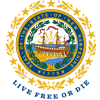Press Release
Contact
(603) 271-3136 | shelly.angers@dncr.nh.gov
USDA Forest Service approves NH’s State Forest Action Plan
The New Hampshire Department of Natural and Cultural Resources, Division of Forests and Lands recently received official approval from the USDA Forest Service of New Hampshire’s 2020 Forest Action Plan, a ten-year strategic document that provides long‐term, comprehensive and coordinated strategies for addressing the challenges and opportunities facing New Hampshire’s forests.
Created in collaboration with many partners and stakeholders, including the N.H. Forest Advisory Board, the plan serves as a guide for use by government agencies, educational institutions, non-profit organizations, landowners, natural resource professionals and private industry to proactively address issues facing New Hampshire’s trees and forests.
“Our forests are vital to our state’s economy, our environmental quality and our cultural identity,” said Charlie Niebling, chair of the N.H. Forest Advisory Board. “The State Forest Action Plan is our blueprint for collective action and awareness to ensure that we conserve the important contributions our forests make for future generations.”
“As the second-most forested state in the nation, New Hampshire is blessed with abundant forests that provide a host of values including wood products, wildlife habitat, clean water and recreation,” said State Forester Patrick Hackley, director of the N.H. Division of Forests and Lands. “This forward-looking plan will help guide public and private land managers in sustaining those values and meeting the challenges we face well into the future.”
“This plan is the result of two years of hard work by Forests and Lands’ staff in collaboration with many agency partners and stakeholders, and includes valuable input from the public,” said Department of Natural and Cultural Resources’ Commissioner Sarah Stewart. “I encourage everyone interested in New Hampshire’s forests to read the plan and become involved in the issues impacting its future.”
Continuing the tradition begun in 1952, the 2020 Forest Action Plan describes the condition of New Hampshire’s forests and articulates a vision for the future. It presents a variety of actions to address the question of what we must do to sustain New Hampshire’s forests and the economy that depends on them, and how we might use various means to achieve the vision. It is the sixth such plan to be written in New Hampshire in 60 years.
With the 2008 Farm Bill, Congress tasked the states and territories with assessing the condition of trees and forests within their boundaries, regardless of ownership, and developing strategies to conserve working forest landscapes, protect forests from harm, and enhance public benefits from trees and forests. The resulting state Forest Action Plans offer practical and comprehensive roadmaps for managing the states forests and are required in order to receive cooperative forestry assistance funds through the US Forest Service.
Like earlier plans, this plan responds to new issues and ideas that are important to our times. Key themes addressed in the 2020 Plan include the need to maintain and strengthen public policy that allows forestland owners to keep their land as forests; climate change and how it will influence the future of our trees, forests and ecosystem health; maintaining a healthy and diverse forest while minimizing the impact of invasive species on forest health; addressing the future of New Hampshire’s forest products markets and identifying new sustainable markets; and increased interest in forest-based recreation including identification and management of recreational impacts on natural resources.
To view a copy of the “2020 N.H. Forest Action Plan,” please visit nh.gov/nhdfl or contact the Division of Forests & Lands at 603-271-2214.
New Hampshire’s Division of Forests and Lands is part of the Department of Natural and Cultural Resources. NHDFL’s mission is to protect and promote the values provided by trees, forests and natural communities. This mission is accomplished through responsible management of the state’s forested resources; by providing forest resource information and education to the public; and through the protection of these resources for the continuing benefit of the state’s citizens, visitors, and forest industry.



